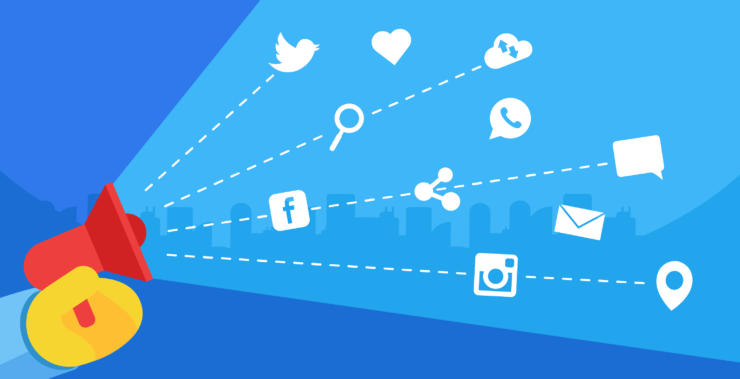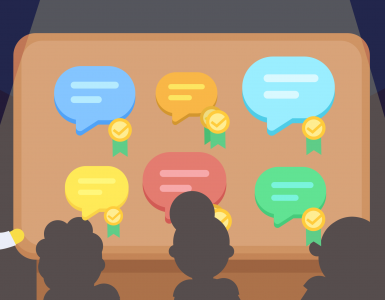A known fact would be that effective communication is the strengthening base for any successful organization. However, it might be difficult to see through the best communication channel or medium to send your message across. Digging into the knowledge of various mediums of communication and their uses can help you identify which one suits your objective the best.
In this reading, I will talk about what a communication medium is, how it has evolved over time, the importance of choosing the right communication medium, types of communication mediums and finally the tips for choosing the best one for yourself.
So let’s begin by defining a communication medium
A communication medium is a channel or route in the communication process through which a sender communicates their message to the receiver. This can take various forms which will be elaborated on later in this reading but a few examples could include emails, voice messages, etc.
In a nutshell, mediums of communication are intended to send out your message to the targeted audience.
Have communication mediums evolved over time?
The presence of the internet and mass media has changed a lot of things for good. Before this breakthrough, books, messages and literacy were handwritten which is why it was not widespread.
However, as the mediums of communication evolved over time, business communication practices and techniques also changed with it. Human communication was freed from the medium of just face-to-face interactions due to the advent of writing technology.
By automating the development and dissemination of written text, printing press technology significantly advanced the medium of writing. In comparison to handwritten texts, this marked a new development of mass communication in the form of brochures, magazines, newspapers, blogs, and so much more.
Is it really important to choose the mediums of communication carefully?
Selecting the appropriate channel is essential to guarantee that your message reaches your targeted audience and that they fully comprehend the message’s meaning and significance. When you select the ideal medium, the audience is much more inclined to listen, see or read what you’re saying and comprehend it. This, in turn, can significantly enhance brand loyalty among your audience, as they are more likely to engage with and trust your message.
Interacting with a person for a face-to-face conversation, for instance, might ensure that they understand your intended message and also have the opportunity to ask questions for clarification. Sending an email, on the other hand, may be preferable in a less urgent communication environment or when interacting with someone distant.
Let’s dig into the various types of communication mediums
In-person communication
Among the many channels, in-person communication, also famously referred to as face-to-face communication is one of the most popular types of communication models. Just like the name suggests, this is when two or more people interact with one another in person.
However, it may be either a one or two-way communication – for example, if a speaker is giving a presentation on the company products to a group of consumers in an event; it will be regarded as a one-sided communication.
On the other hand, if the consumers participate in the presentation then it will more likely be a two-way form of communication.
Moreover, one of the biggest advantages of in-person communication is being able to use, read, and see the facial or body expressions also referred to as the non-verbal cues of the speaker and audience.
So let’s suppose, you are the speaker, given the non-verbal cues of your audience, you can easily judge if they can gauge your message well – or perhaps are not too bored with your speech. Either way, you can alter your speech and get their attention so you get your message across well.
In contrast, the audience will also be able to read through your non-verbal cues so make sure to interact with your hand gestures, facial expressions and body language to make it all more interesting and engaging.
The immediacy of this medium of communication is a big bonus. Everyone can take part in the conversation at hand. This enables a free and open exchange of ideas without having to wait for a response.
Virtual communication
Virtual communication is the use of the internet to send messages to the desired audience. It can take various forms including verbal and non-verbal communication
Email, for instance, is a very common form of virtual communication.
It’s actually one of the best ways to get your message across to both a mass audience or even a single person – be it sending out promotional emails to your subscribers or an important document to a coworker; emails are an all-rounder!
You can also add a CTA to your email signature to clarify what you want from the reader and provide a link to the appropriate destination.
Sending texts or instant messages, scheduling video or audio calls, or using a pager or intercom calls are also other forms of virtual communication.
As a matter of fact, virtual communication is regarded as an excellent form of communication medium for remote teams. During and after the pandemic, people used this medium of communication the most and have now become accustomed to its benefits and usage.
Printed communication
As a result of technological improvements despite being less widespread, printed communication, also known as written communication, can nevertheless play a vital role in the workplace. Some examples may include diaries, handwritten notes, and memoranda.
Depending on the situation, printed communication can be both informal and formal; and can also go in the form of technical communication. An informal form of communication, for example, is leaving a handwritten note as a reminder to colleagues. On the other hand, a handwritten note for an invite to an event to a colleague is a form of formal printed communication.
Printed communication, like remote communication, is less intimate than in-person communication.
Digitally social communication
This is a form of online communication generally done on the social platforms of an organization or individual. Communication on these platforms is commonly used to interact with the external audience i.e. the consumers as opposed to the internal audience i.e. your employees.
Many businesses utilize social media to reach out to their target audiences with promotional campaigns. Businesses use social media to capture customers’ attention, and it can mix many communication mediums.
Some platforms, such as Facebook or Instagram support graphics such as photos to communicate, while others such as YouTube focus on video communication. Many social media platforms allow people to communicate in both public and private chats, allowing two or more people to talk.
Internally, certain businesses or work groups may use social networking. For instance, co-workers may use messaging tools to deliver messages to each other rapidly. In other cases, people may undertake outreach with possible Wholesale business partners using professional social media channels such as LinkedIn.
Twitter is a good channel to develop public brand personality. Because it’s recommended that you post up to 15x a day, a variety of Twitter management tools can help you schedule your plan and posts in advance.
Despite the fact that social media is often regarded as an informal medium of communication, it can be a useful approach to interact with a target audience or audience to interact with you for that matter.
Tips for choosing the right mediums of communication
While it may be appealing to interact through every medium, most firms would benefit from a more measured and thoughtful strategy. Before you choose a medium for your intrapersonal communication, you may consider the following points.
Consider the relationship with your communicative audience
Your relationship with your consumers, co-workers or boss is also an element of choosing the right medium. If you want to communicate with your co-worker, chances are that some people would even be comfortable with WhatsApp.
However, for your consumers, it is more advisable to get your message across through emails using email marketing software, social media platforms, or custom mobile apps.
Moreover, how you communicate with your boss also depends on the leadership styles that they have adopted.
In some firms, you can only email them while in some you can even text them. A more professional approach towards this would be to get your message on an email for better documentation too.
Familiarize yourself with the needs of your team
It may seem apparent, but the medium of communication you choose is primarily determined by your team’s preferences. What kind of a team do you have and how or where do they prefer to communicate? Is it through audio, video, or just text messages?
To familiarize yourself with this situation, you may conduct employee surveys to know what suits their needs the best. Understanding where your employees spend most of their time can also aid in selecting the appropriate medium of communication.
For example, your team may be more equipped with using collaboration tools such as Chanty as a communication channel – or perhaps they simply use a messaging app like WhatsApp.
The level of urgency for your message
Urgency can also define the medium of communication that you should generally use. Take into account the importance of your message and the likelihood that your target audience will understand and respond to it depending on the channel.
Let’s take the example of contacting your coworker outside business hours for an urgent matter – emailing them for this purpose may not be the best solution, however, a phone call is more suitable for such situations.
Similarly, as stated above, since written communication lacks the intimacy of in-person contact therefore it may not elicit instant responses. In contrast, you may get a more natural response when talking in person.
In a nutshell, you need to identify the level of urgency in the responses to your message and thus choose the medium therein.
Examine your financial situation
Because you’ll have to spend money to get your word through, your spending plan will have an impact on the communication mediums you choose. Consider this: Is the medium within your firm’s total expenditure?
You may be able to find affordable plans for communication mediums and tools. Or you are probably looking out for expensive options. This requires you to analyze the allocated budget of your organization and choose a channel that best suits your needs.
The type of communicative information
Particular mediums make it easier to convey various kinds of information. When sharing facts with your audiences, for instance, using visual clues might help you communicate more effectively.
If you’re addressing data trends, you might use a medium of communication that enables you to include graphics, such as graphs and charts. Having a written record of information that you may have to provide a reference to in the future can assist you in storing that information. If you want to document a chat, you might opt to utilize email or a written memo.
Consider the nature of your message
While some messages are formal, others are informal. A handwritten note is generally more informal than a formal email or a printed document.
Therefore, if the nature of your message is such that it is formal, for example calling a candidate for an interview, then consider using formal mediums of communication as well such as an email or a formal phone call, or even a formal social platform such as LinkedIn.
However, if it is informal, such as giving a thank you card to a coworker for their support on a project, then a simple handwritten card will also suffice.
Overall, the future entails consolidating all the different mediums of communication channels into a single platform that will act as a central source of pertinent information for each employee. For this purpose, there are a bunch of communication and collaboration platforms that can assist purpose.
For example, Chanty helps you integrate all your synchronous communication under a single roof. With third-party integrations, you can easily manage a variety of tasks in just one download.











Nice Post
Very Informative